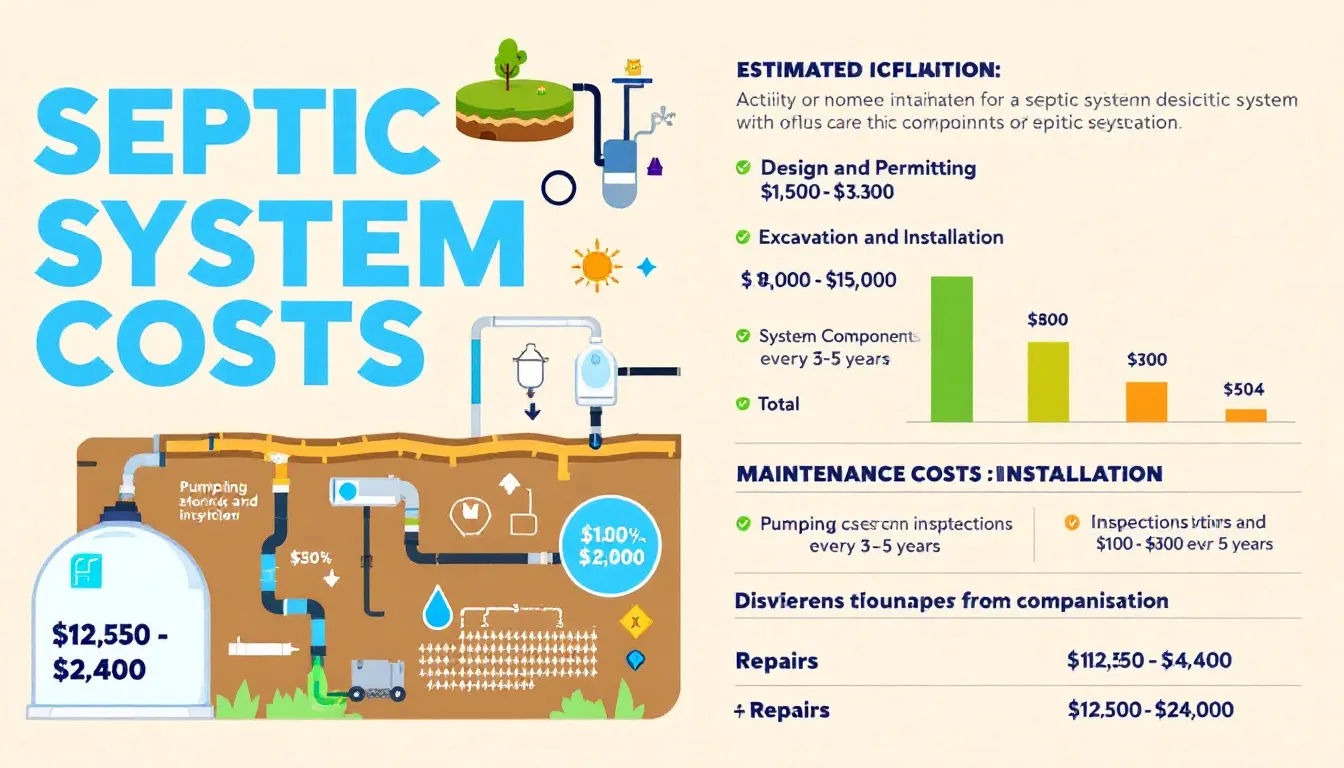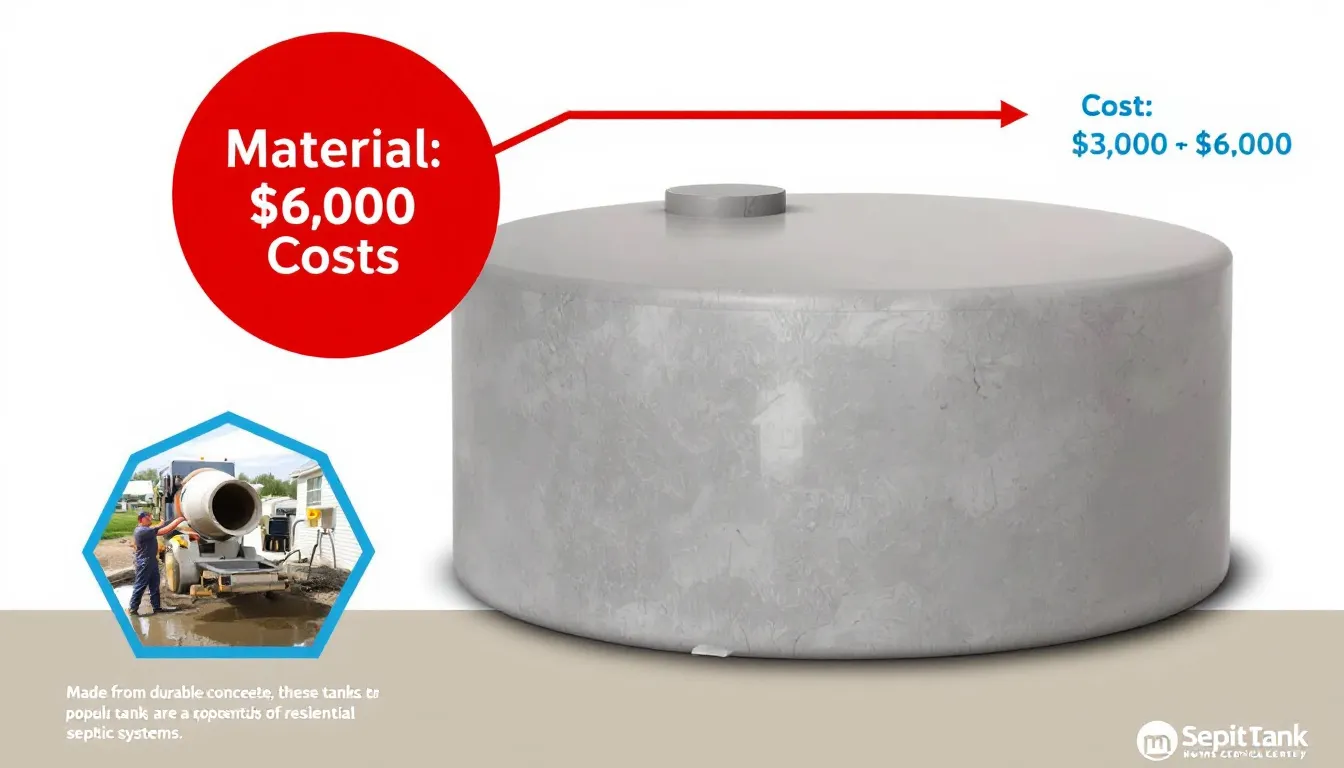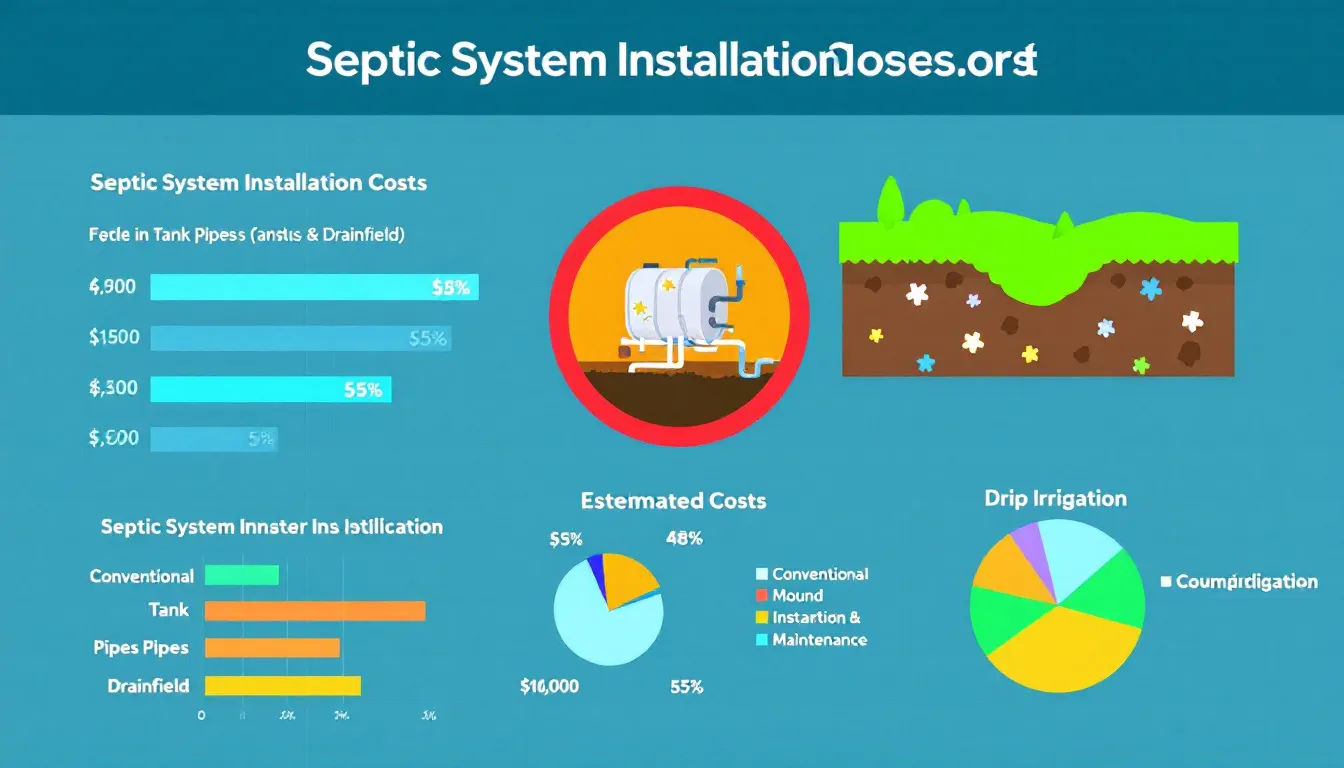If you’re wondering ‘how much does a septic system cost,’ expect to pay between $3,615 and $12,408 on average. Various factors, such as the type of system, material, property specifics, and additional expenses, can influence these costs. In this guide, we’ll break down everything you need to know about septic system costs in 2025 to help you plan your budget effectively.
Key Takeaways
- Septic system costs range from $3,615 to $12,408, with an average of $8,011, influenced by system type and property characteristics.
- Maintenance is crucial for septic systems, with regular costs between $250 and $500 every three to five years to prevent costly repairs and protect public health.
- Financing options, such as home equity loans and personal loans, can help homeowners manage septic system costs, with advice to compare interest rates and terms before proceeding.
Understanding Septic System Costs

The expense of installing a septic system can fluctuate widely. Homeowners might spend anywhere from $3,615 to $12,408 on average, with the median outlay being around $8,011. The cost is influenced by several variables including the type of septic system you choose to install, the materials used in its construction and particular characteristics of your property.
Before commencing with a septic tank installation, it’s crucial to perform soil tests that confirm whether your ground conditions are suitable for such a setup. Consulting local health departments could also reveal ways to economize while ensuring all necessary permits are in order. These preparatory steps allow homeowners an accurate forecast of their potential expenditure on a new septic system.
Another key determinant affecting overall costs is the size requirement for the septic tank itself. Typically dictated by both property dimensions and household occupancy levels (e.g., number of bedrooms). Taking into account these essential considerations helps those looking into this significant home investment anticipate associated financial commitments better when planning for their septic system installation.
Types of Septic Systems and Their Costs

There are multiple septic system options available, all of which have distinct cost considerations based on the specific type chosen. Soil condition, the scale of your property, and local ordinances significantly affect both your selection and the ultimate expense associated with installing a septic system. Conventional and anaerobic systems exist. Offer more economical solutions. To their pricier counterparts like aerobic treatment units.
To optimize waste management efficiency and achieve cost savings over time, it’s essential to select an appropriate septic system for your premises. Below you’ll find a rundown of various septic systems including their respective costs and features to guide you toward a well-informed decision.
Conventional Septic Systems
Many homeowners prefer conventional septic systems for their affordability and straightforward design. The standard installation expense for a basic anaerobic septic system falls between $3,000 and $8,000. Such systems typically comprise a combination of a septic tank and drain field to process and distribute the household wastewater efficiently.
It is usually advised to use a 1,250-gallon septic tank for homes with three or four bedrooms. The dimensions of the septic tank are crucial as they determine both its cost and the necessary size of the accompanying drain field. For these traditional setups, concrete septic tanks are frequently selected due to their robustness and long-lasting qualities.
Aerobic Septic Systems
While aerobic septic systems come with a heftier price tag, often ranging from $10,000 to $20,000, they compensate for the cost by delivering enhanced efficiency and necessitating a more compact drain field. Employing oxygen in the waste degradation process allows these systems to work faster than their anaerobic counterparts, rendering them an ideal choice for properties where soil conditions are less than optimal.
The installation of an aerobic septic system typically involves extra elements such as aerators, electrical connections, and pump tanks—all of which contribute to its higher initial expenditure. It’s important to note that maintaining this type of system requires abstaining from using harsh chemicals that could harm the essential bacteria within it. Its efficiency greatly depends on these microorganisms’ health.
Alternative Septic Systems
Septic systems designed for alternative situations cater to properties with unique challenges, offering a range of solutions that may be suitable. The price tag for these systems can reach as high as $20,000 based on the specific system chosen and the conditions at the site where they are to be installed. Mound septic systems are an example of a new septic system well-suited for locations with shallow soil. Their costs fall between $10,000 and $20,000.
There are additional choices like built wetland septic systems which have an estimated cost ranging from $5,000 to $12,000 and sand filter systems whose prices vary from $7,000 to 18,000 dollars. These alternatives not only accommodate various property constraints but also provide ecological advantages—making them particularly useful under certain circumstances.
Material Costs for Septic Tanks

The overall cost of a septic system is heavily influenced by the material chosen for the septic tank. There are several materials available for constructing septic tanks, each providing distinct durability and price points. On average, the expense associated with purchasing a septic tank falls between $500 and $2,500. To ensure lasting effectiveness and financial practicality, it’s essential to choose an appropriate material for your septic tank.
Each type of material used in manufacturing septic tanks—concrete, plastic, and fiberglass—comes with its unique set of benefits and drawbacks which influence their costs as well as characteristics.
Concrete Septic Tanks
Septic tanks made of concrete are favored for their robustness. The cost of a septic tank falls between $700 and $2,000. Despite their longevity, they can develop cracks as time passes, potentially requiring maintenance or replacement.
Plastic Septic Tanks
Septic tanks made of plastic are the least expensive choice, with prices ranging from $500 to $2,000. These tanks are known for their lightweight nature and ease of installation. They have a tendency to crack which can lead to the need for septic tank replacement sooner than with concrete tanks.
Fiberglass Septic Tanks
Prices for fiberglass septic tanks range from $1,200 to $2,000 due to their esteemed durability and corrosion resistance. These tanks are less prone to cracking, providing homeowners with a durable option that is likely to last longer. The cost of fiberglass septic tanks corresponds with the quality and extended lifespan they provide.
Installation Costs

The typical range for installing septic systems falls between $3,615 and $12,408, with the average cost hovering around $8,011. The portion attributed to labor costs is substantial—comprising 50% to 70% of the total outlay—and excavation alone can escalate this by an additional $1,500 to $6,300.
Permit acquisition stands as another essential cost determinant. Fees for permits fluctuate from as low as $320 up to a high of about $1,880 based on one’s specific location and the governing local regulations in that area. Conducting a percolation test—which assesses soil absorption capacity—is necessary and may introduce Expenses ranging from approximately $450 up to roughly about $1,400.
Labor Costs
Depending on the region, labor expenses associated with installing a septic system typically vary between $1,500 and $4,000. Site conditions can greatly affect these costs. Specifically, excavation work can lead to an additional increase in labor charges that may fall anywhere from $1,500 to $6,300.
Permits and Testing
The cost range for securing permits needed to install septic systems typically spans from $320 to $1,880. These planning and permitting expenses differ depending on the geographical area and are influential factors in the total costs associated with installing a septic system.
Meanwhile, percolation tests that evaluate the soil’s ability to absorb water can incur charges ranging from $450 to $1,400.
Additional Costs to Consider
Aside from the fundamental costs associated with materials and installation, there are other expenditures that need to be taken into account. For instance, supplementary components such as pumps and alarms may increase the overall expense by an estimated $1,000 to $3,000. Costs can also arise from replacing a tank cover or fitting a distribution box.
The creation of a leach field presents another considerable financial aspect, with prices fluctuating between $5,000 and $12,000. Design and engineering services related to septic system installations could set one back an additional sum ranging between $500 and $3,000. These figures underscore the necessity of planning for extra outlays that might occur during this process.
Drain Field Costs
Typically, the installation of a drain field may incur an average expense of approximately $10,000. This cost can fluctuate between $5,000 and $12,000 depending on factors such as the size of the septic tank associated with the home.
Accessory Costs
Additional components such as pumps and alarms can significantly increase the overall expense of septic system installations, potentially adding between $1,000 to $3,000 to the foundational installation costs.
Financing Your Septic System

Financing options are available to help homeowners manage septic system costs. Home equity loans, personal loans, and home improvement loans are common choices. Factors such as the amount needed, timing, project type, and repayment duration determine the best financing option.
Comparing interest rates, terms, and fees is crucial when considering financing options. Homeowners with a good credit score may qualify for lower-interest or zero-interest rate loans, while those with bad credit may find personal loans less favorable.
Home Equity Loans and Lines of Credit
Financing for septic system installations is frequently obtained through home equity loans or lines of credit. The value of one’s home equity dictates how much can be borrowed, with the property being used as security for the loan.
Access to more favorable interest rates is a financial advantage provided by these methods when investing in a septic system.
Personal Loans
Homeowners can finance the expenses involved in installing a septic system by taking out personal loans, which are available to cover septic system costs. The interest rates on these loans can differ greatly and are highly contingent upon the individual’s credit score, influencing their cost of borrowing based on their financial reliability.
Tips to Save Money on Septic System Installation
Several effective strategies can be employed to minimize the total cost of a septic system. Undertaking part of the installation work personally, like carrying out excavation duties, may decrease labor costs significantly. Securing estimates from various contractors is key to ensuring you receive a competitive rate for installing your septic system.
Procuring materials independently could circumvent potential surcharges applied by contractors if they consent to install these items. Readying the site and making sure that all requisite permits are in place beforehand may prevent unforeseen expenses down the line.
Get Multiple Quotes
Obtaining a variety of estimates for the installation of your septic system can aid in securing the most competitive rate while also guaranteeing that you are engaging with companies that are both skilled and insured, thus offering reassurance throughout the setup phase.
Purchase Materials Yourself
Purchasing materials on your own can help you bypass additional costs. It’s beneficial for homeowners to verify whether contractors are open to the idea of installing materials that were bought independently. Typically, smaller contractors might offer more leeway and agree to use materials procured by the homeowner, which could result in substantial cost reductions.
Nevertheless, it is critical to recognize that certain contractors may hesitate to work with materials supplied by homeowners due to potential liability issues.
Maintaining Your Septic System
To ensure a septic system operates efficiently and avoids expensive repairs, it’s critical to adhere to regular maintenance. The typical cost for maintaining a septic system falls between $250 and $500 every three to five years, which is quite reasonable compared to the expenses that could arise from neglecting such maintenance. Early identification of potential issues through regular upkeep can substantially minimize costs over time.
For peak performance of your septic tank, it is advisable to perform septic tank pumping once every three to five years. Setting up routine inspections biennially or triennially will aid in averting failures within the system and help extend its overall service life. Owners of more complex advanced septic systems should consider scheduling even more frequent evaluations due to their intricate nature.
Commitment towards comprehensive care for your entire septic system not only boosts its durability, but also acts as a safeguard for public well-being by preventing hazardous bacteria contamination risks. An inadequately maintained system might contribute pollution into groundwater sources—endangering both human health via drinking water supplies and threatening surrounding ecological habitats.
Signs Your Septic System Needs Attention
Being aware of indicators that your septic system requires maintenance can prevent expensive repair work. One clear sign of a failing septic system is when sewage starts to back up into household sinks and drains. The presence of standing water or continuous moisture around the drain field area points to malfunctioning within the septic system.
Unpleasant smells emanating from plumbing fixtures or on your property could be symptomatic of a compromised septic system. If you notice that drains in different areas of your home are emptying slower than usual, it might mean the septic tank is reaching capacity or experiencing technical difficulties. Odd gurgling sounds during plumbing use may denote blockages or other problems in the system.
Lush patches of unusually green grass above the drain field often reveal leaks from beneath due to excess nutrients feeding plant growth. Keeping an eye out for these telltale signs allows for prompt intervention which helps prevent extensive and expensive repairs to your septic system.
Summary
Comprehending the financial aspects of septic systems is vital for homeowners who wish to efficiently handle their budgeting. This includes being aware of not only the variable upfront costs associated with installation, but also the recurring expenses necessary for maintaining these systems. Knowledgeable decision-making can be influenced by understanding what each type, whether it’s a standard, aerobic, or alternative system, entails in terms of investment and advantages.
The selection of materials such as concrete, plastic, or fiberglass has a considerable impact on both initial expenditure and the enduring quality of your septic system. It’s essential to weigh up front expenditures against ongoing upkeep requirements and potential repair outlays over time. Committing to routine inspections and recognizing indications that require professional attention can stave off expensive malfunctions while prolonging your system’s functionality.
In essence, taking an active role in caring for your septic setup combined with staying well-informed about its needs could lead to substantial savings while ensuring optimal performance through the years ahead. Bear in mind that sustaining a properly functioning septic system represents more than just an economic undertaking. It reflects dedication toward safeguarding both personal real estate assets as well as environmental integrity.
Frequently Asked Questions
How much does a septic system cost on average?
On average, the cost of septic systems is slightly above $8,000. Prices usually vary from $3,615 to $12,408.
Hence, it is wise to plan your finances within these figures when you’re looking into installing or replacing a septic system.
What factors influence the cost of a septic system?
The overall investment required for a septic system is significantly affected by various factors, including the type of system selected, the materials used, the quality of soil on the property, prevailing conditions of said property, and the size requirements for the septic tank. Each element is critical in shaping the final cost.
How often should a septic tank be pumped?
To maintain optimal performance, a septic tank should be pumped every three to five years.
Regular maintenance is essential to prevent system failures.
What are the costs associated with installing a drain field?
Setting up a drain field will incur expenses ranging from $5,000 to $12,000. The mean cost for such an installation hovers around the $10,000 mark.
As a result, it is crucial to allocate funds appropriately for undertaking this endeavor.
Can I finance my septic system installation?
Yes, homeowners can finance septic system installation costs through options like home equity loans, personal loans, or home improvement loans.
Consider researching these financing methods to find the best fit for your needs.




